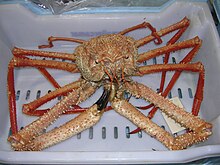| Homoloidea Temporal range:
| |
|---|---|

| |
| Paromola cuvieri | |
| Scientific classification | |
| Domain: | Eukaryota |
| Kingdom: | Animalia |
| Phylum: | Arthropoda |
| Class: | Malacostraca |
| Order: | Decapoda |
| Suborder: | Pleocyemata |
| Infraorder: | Brachyura |
| Section: | Dromiacea |
| Superfamily: | Homoloidea De Haan, 1839 |
| Families | |
Homoloidea is a superfamily of dromiacean crabs. Homoloidea belongs the group Dromiacea, taxonomically ranked as a section, and is the sister group to Dromioidea. Dromiacea is the most basal grouping of Brachyura crabs, and likely diverged from the rest of Brachyura around the Late Triassic or Early Jurassic.[1][2] The close relation between Homoloidea and Dromioidea is primarily established through ultrastructural characteristics of the sperm.[3]
The below cladogram shows Homoloidea's placement within Dromiacea:[1]
| Dromiacea |
| ||||||||||||||||||
Recent studies have found that the Homoloidea family Homolidae is paraphyletic with respect to Latreilliidae.[1]
See also
[edit]References
[edit]- ^ a b c Ling Ming Tsang; Christoph D. Schubart; Shane T. Ahyong; Joelle C.Y. Lai; Eugene Y.C. Au; Tin-Yam Chan; Peter K.L. Ng; Ka Hou Chu (2014). "Evolutionary History of True Crabs (Crustacea: Decapoda: Brachyura) and the Origin of Freshwater Crabs". Molecular Biology and Evolution. 31 (5). Oxford University Press : 1173–1187. doi:10.1093/molbev/msu068. PMID 24520090.
- ^ Wolfe, Joanna M.; Breinholt, Jesse W.; Crandall, Keith A.; Lemmon, Alan R.; Lemmon, Emily Moriarty; Timm, Laura E.; Siddall, Mark E.; Bracken-Grissom, Heather D. (24 April 2019). "A phylogenomic framework, evolutionary timeline and genomic resources for comparative studies of decapod crustaceans". Proceedings of the Royal Society B. 286 (1901). doi:10.1098/rspb.2019.0079. PMC 6501934. PMID 31014217.
- ^ Joel W. Martin & George E. Davis (2001). An Updated Classification of the Recent Crustacea (PDF). Natural History Museum of Los Angeles County. pp. 1–132.

Well, that’s interesting to know that Psilotum nudum are known as whisk ferns. Psilotum nudum is the commoner species of the two. While the P. flaccidum is a rare species and is found in the tropical islands. Both the species are usually epiphytic in habit and grow upon tree ferns. These species may also be terrestrial and grow in humus or in the crevices of the rocks.
View the detailed Guide of Psilotum nudum: Detailed Study Of Psilotum Nudum (Whisk Fern), Classification, Anatomy, Reproduction